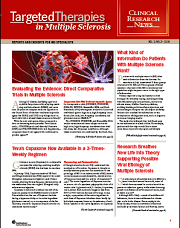Publication
Article
Targeted Therapies: Multiple Sclerosis
Research Breathes New Life into Theory Supporting Possible Viral Etiology of Multiple Sclerosis
Author(s):
Although multiple sclerosis is likely a result of multifactorial influences, there is some evidence that viruses play a role in the disease.

Several clusters of multiple sclerosis (MS) have been identified around the world, some of which have occurred in association with exposure to infectious agents, while others have suggested an influence of environmental toxins, such as heavy metals.1,2
Although MS is likely a result of multifactorial influences, there is some evidence that viruses play a role in the disease. For example, in the Faroe Islands, which lie northwest of Scotland and halfway between Iceland and Norway, native residents began to develop MS starting in 1943 after British occupation of the island during World War II. Although no virus was ever identified, John F. Kurtzke, MD, creator of the Kurtzke Expanded Disability Status Scale, said he believes the Faroe Island cluster suggests a viral etiology of MS.3-5
In a scientific paper published in 2013 in the journal Brain, Kurzke wrote, “As of 1999, we had found 189 suspected cases, and we had agreed that 83 of them were examples of MS… There is no evidence that MS occurred among native-born resident Faroese before July 1943, when symptoms began in one patient… The abrupt onset indicates that the disorder had to have been introduced into the islands at a single time.”
In later research, Kurtzke, who is professor emeritus at Georgetown University in Washington, DC, identified similar patterns of MS incidence in Iceland and the Shetland-Orkney islands.4 Kurtzke and colleagues also examined the prevalence of MS in populations migrating from equatorial regions (where the prevalence of MS is low) to higher latitude regions (where the prevalence of MS is higher). From these studies, Kurtzke concluded that MS may be partly caused by a virus acquired before the age of 15 years, which may then lead to MS symptoms after a delay of 15 to 20 years.4
Adding to the knowledge base developed by Kurtzke about the relationship between MS and viruses, Julian Gold, MBBS, MD, of the Albion Street Centre in Sydney, Australia, and colleagues studied the link between MS and human immunodeficiency virus (HIV). HIV and MS are both well-characterized conditions, although they rarely occur in the same patient.6
In 1996, Gold noticed that one of his patients who had both MS and HIV experienced a reduction in symptoms after starting antiretroviral therapy. Over 12 years of therapy, the patient continued to experience few symptoms of MS. Based on this case, Gold hypothesized that the antiretroviral medication, the immunosuppression associated with HIV, or both, might slow the progression of MS.6
To evaluate the hypothesis, researchers in Denmark studied the incidence of MS in patients with HIV. Investigators followed 5018 patients with HIV over a median of 5.2 years and compared those results with a control population of 50,149 MS-free individuals who were followed for a median of 7.6 years.6
Seven cases of MS were observed in patients with HIV, even though approximately 18 cases would be expected in a comparable group of patients without HIV. The relative risk of developing MS was significantly lower among patients with HIV, with new cases of MS occurring at more than one-third (38%; 95% confidence interval [CI]: 15%-79%) the rate observed in the general population.6
In a secondary analysis, investigators analyzed MS cases that were identified in patients 1 year or more after they acquired HIV. A total of 3 such cases were identified. Although this number was smaller than the expected number of 13 cases of HIV that would be expected to occur in a similar population without HIV, the result was no longer statistically significant (hazard ratio: 0.25; 95% CI: 0.07-0.65). The lack of statistical significance may be a result of the small number of MS cases observed in patients with HIV.6
According to Gold, who presented his research in MS at the Barts and London School of Medicine and Dentistry on MS Research Day in 2013, “As a result of these observations, we are now launching a unique clinical trial … the INSPIRE trial.” This trial will begin with a pilot phase in which patients with RRMS will receive raltegravir over a 3-month baseline period and a 3-month treatment period. Patients will be evaluated for the primary outcome of new gadolinium-enhancing lesions.7,8
Gold compares the pathophysiology of MS with a car lying in pieces: “It’s very complicated…all over the world there are researchers working on little bits to do with MS. Some are working on vitamin deficiencies, and others are working on Epstein-Barr virus (EBV), and others are working on hypoxia, but nobody has been able to put all these pieces together and drive it away.”7
The pathophysiology of MS is very complex and the involvement of viruses is far from certain. For now, the use of antiviral agents in patients with MS should be limited to the clinical trials setting.
References
1. Perron H, Garson JA, Bedin F, et al. Molecular identification of a novel retrovirus repeatedly isolated from patients with multiple sclerosis. The Collaborative Research Group on Multiple Sclerosis. Proc Natl Acad Sci U S A.1 997;94(14):7583-7588.
2. National Multiple Sclerosis Society. MS Clusters. http://www.nationalmssociety.org/What-is-MS/What-Causes-MS/Clusters#section-2. Accessed August 2014.
3. Confavreux C. An unchanging man faced with changing times. Brain. 2012;135(pt 6):1663-1665.
4. Kurtzke JF. Epidemiology in multiple sclerosis: a pilgrim’s progress. Brain. 2013;136(pt 9):2904-2917.
5. National Multiple Sclerosis Society. Kurtzke Expanded Disability Status Scale (EDSS). http://www.nationalmssociety.org/NationalMSSociety/media/MSNationalFiles/Brochures/10-2-3-29-EDSS_Form.pdf. Accessed August 2014.
6. Gold J, Goldacre R, Maruszak H, Giovannoni G, Yeates D, Goldacre M. HIV and lower risk of multiple sclerosis: beginning to unravel a mystery using a record-linked database study [published online ahead of print]. J Neurol Neurosurg Psychiatry. 2014. doi:10.1136/jnnp-2014-307932.
7. Gold J. MS Research Day talk— Julian Gold. https://www.youtube.com/watch?feature=player_embedded&v=Ss5alRN9voA. Accessed August 2014.
8. ClinicalTrials.gov. Raltegravir (Isentress) Pilot Study in Relapsing Multiple Sclerosis (INSPIRE). http://clinicaltrials.gov/show/NCT01767701. Accessed August 2014.
2 Commerce Drive
Cranbury, NJ 08512
All rights reserved.





